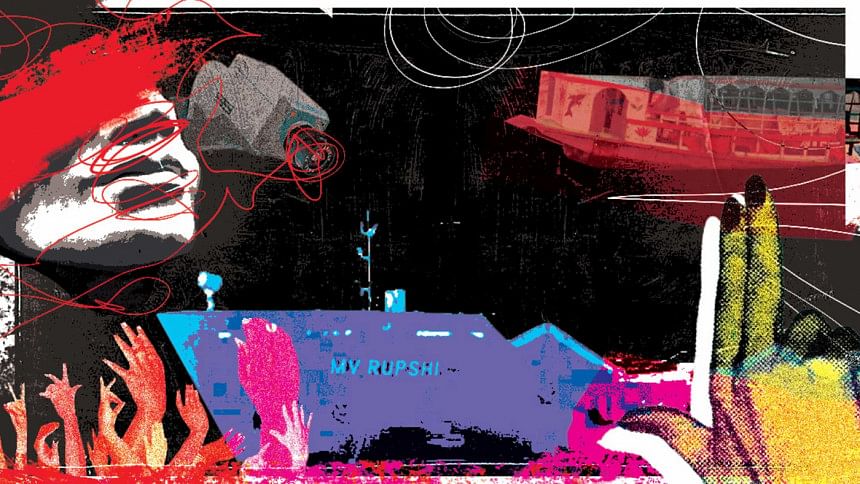Ferry disasters: Let’s not sugarcoat institutional murders

It's like a scene from a Stephen King movie: a small passenger vessel being "devoured" by a cargo ship about 20 times its size. But perhaps even the master of horror couldn't have produced a moment so short yet so fateful. Video clips capturing this tragic encounter on the Shitalakkhya River on March 20 show how panicked passengers of the Munshiganj-bound ML Afsar Uddin vessel screamed as the much larger MV Rupshi 9 cargo ship crept up on the former and, without warning, ploughed into it. The ship continued to push forward until some passengers jumped into the river. Seconds later, the smaller vessel sank, with many passengers still on it, while the ship went along like nothing had happened.
You normally use words like "plough" when describing some highway crashes. "The truck ploughed into a van," you say, or "The train crashed into a stranded car." The "killer truck" epithet owes its origin mostly to this type of impact. It's a standard trope for crime thrillers as well. One may also recall the 2016 terrorist attack in France, in which the world was shocked by the audacity of a cargo truck being driven into crowds celebrating the Bastille Day, killing 86 people.
So it takes some imagination to think of a similar occurrence on the waterway, where you least expect such collisions. Yet, here we are.
Reports published after the March 20 ferry disaster, which recorded at least 10 deaths so far, describe emotional scenes of people searching for their missing relatives or mourning the dead. Some of the headings aptly captured their mood: "I need no compensation, just find my husband's body," said Momela Begum about her husband who returned from Kuwait only a month ago. "My child, I can't bear losing you," cried Jayaram Rajbangshi, holding the lifeless body of his three-year-old daughter. "Are we doomed to die like this? Die again and again?" said Minu Begum, who lost her nephew's wife and daughter before losing her daughter-in-law and granddaughter in another launch tragedy on the Shitalakkhya last year. "Will there be no punishment for the murderers?" asked another grieving relative.
These expressions of pain and sorrow remind us that there's no tragedy like the loss of a loved one, especially in such pointless deaths.
When the relatives talk about murderers, they don't just mean the crew members of those vessels who failed to prevent the collision. They also mean the vessel owners and the state regulators, who together are responsible for creating an environment in which ordinary passengers are basically sitting ducks waiting for something bad to happen when out in the waterways. The relatives have a fair point: if a person killing another person is called murder, why can't we call an institutional murder for what it is? After all, when institutional failures, incompetence and negligence are encouraged rather than punished, such catastrophes—either in the form of collision, or fire or capsize caused by internal malfunctions—become inevitable and thereby man-made. To call this outcome an "accident" will be sugarcoating it. And if a person is held responsible for murder, why can't we hold a complicit institution (the official-owner complex) responsible for the same?
Unfortunately, the officials or owners of vessels are rarely held to account for their actions or lack thereof. We see low-level operators rounded up after each incident, which makes for good optics but cannot prevent the recurrence of such tragedies. The same can be said about land transport owners. Or, the regulators and top officials in both sectors. In fact, most tragic accidents in Bangladesh—gas explosion, road crash, fire incident, factory collapse, or launch capsize—can be traced to the failures and negligence of those at the top of the ladder.
Their culpability becomes clear when you consider how water vessels, for example, are caught in a tragic loop of circumstances that makes accidents, small or big, almost predestined. First, you have a system that allows faulty vessels and ill-trained crew members to operate. (Part of the reason why ML Afsar Uddin capsized so quickly was its being a "sunken-deck" vessel, known for having fewer safety measures and no watertight deck which could help it remain afloat for a longer time.) Then, there is the lax enforcement of safety rules and regulations. And then, when something bad happens, you have the usual blame game, knee-jerk damage control, and bountiful lip services without any meaningful reform or accountability measure whatsoever. There is no indication whether this loop or cycle will be broken anytime soon.
Experts generally blame poor regulatory oversight, lack of trained crew members, rise in river traffic (including unregistered vessels), shortage of manpower for safety checks, overcrowding, and an overall culture of impunity for the waterway tragedies, which have been on the rise in recent years. According to Buet's Accident Research Institute (ARI), 110 people were killed in waterway tragedies in 2019, while 264 people were killed in 2020. Last year, some 199 people lost their lives.
The frequency of these incidents should be a wake-up call for those in charge of the Department of Shipping and the Bangladesh Inland Water Transport Authority (BIWTA). They should be honest and acknowledge their failures to prevent such incidents (as all independent probe reports inevitably conclude), and help institute a system of accountability that actually works, regardless of how well-connected or high up the hierarchy one is. They can no longer hide behind excuses or blame games, especially with the monsoon/storm season coming.
There is no dearth of research on why waterway tragedies keep happening in Bangladesh, nor on what should be done to prevent them and modernise the river management system. All this is more or less known already. What we really need now is a push to change how the system works, and ensure accountability for everyone involved in it.
Badiuzzaman Bay is an Assistant Editor, The Daily Star.

 For all latest news, follow The Daily Star's Google News channel.
For all latest news, follow The Daily Star's Google News channel. 



Comments